

Managing construction projects is no easy task, as you must deal with many moving parts. Delivering a project on time and within budget, without a dip in quality, requires proper planning and execution.
However, despite meticulous planning, meeting project deadlines can often be tricky. Internal and external factors can cause critical risks to any project, large or small, adding to the overall cost of operations.
50% of construction firms reported that they have either canceled, postponed, or scaled back projects due to increasing costs.
Delays, budget overruns, and safety concerns can threaten project success and leave you scrambling. However, with proper planning and tracking of internal and external threats, construction projects can be more productive and cost-effective. Improving construction efficiency has far-reaching effects, as a World Economic Forum study finds that just a 1% reduction in construction costs can save society about $100 billion annually.
In this article, we will look into construction efficiency and understand the role of project management in improving it.
- What is Construction Efficiency?
- Challenges that Impact Construction Workflows
- 10 Strategies to Improve Operational Construction Efficiency
- 1. Create a blueprint for your construction project
- 2. Practice open communication and document everything
- 3. Invest in employee training for higher productivity
- 4. Prioritize safety on the job site
- 5. Approach potential supply chain issues with foresight
- 6. Use modular construction and prefabrication techniques
- 7. Embrace automation to revolutionize construction processes
- 8. Set clear and measurable performance goals
- 9. Streamline construction processes for greater efficiency
- 10. Leverage an end-to-end project management tool for efficiency in construction
- Time to Start Building—The Right Way
- Common FAQs
What is Construction Efficiency?
Operational efficiency is essentially the ratio between the output of a project and the various inputs required to execute it.
In the construction industry, the efficiency of a project is impacted by several factors, including labor, materials, or equipment. Thus, construction efficiency is not just about speed or managing resources.
Instead, it focuses on achieving an optimal balance between project costs, completion time, and quality. The goal is to ensure the project is completed on time, meets the expected quality standards, and is cost-effective.
Since delays can hamper project completion and add to project costs, productivity is directly tied to profitability. So businesses use construction automation tools and construction management software to optimize workflows and improve operational efficiency. The use of technology in construction is at an all-time high, and the right tools can help construction project managers improve efficiency significantly.
Challenges that Impact Construction Workflows
Construction projects are riddled with potential risks, which can be daunting for project managers.
This is because each project needs meticulous tracking of:
- Project costs
- Resource requirements and budgets
- Inventory of materials
- Capital requirements
- Energy input
- Indirect costs
Tracking all these metrics and parameters can often become challenging. Consequently, construction firms often use multiple tools and softwares for tracking specific parameters. They then compare these numbers via a productivity management tool to gauge the efficiency of a construction project.
Some of the primary challenges to operational efficiency in construction include:
1. Lack of clear objectives
Most projects are bound to fail without realistic timelines and clear goals. With proper planning and an execution roadmap that details each team member’s goal and every task’s timeline, construction projects can avoid wasting time and resources. Regularly tracking progress along defined key performance indicators is vital for keeping the project on schedule.
2. Budgetary limitations
It’s pretty common for construction work to go beyond the expected budget. However, if the firm in question does not have a risk threshold for such events, the entire project may be placed on hold.
To avoid this, project plans need to consider external factors like inflation, fluctuating prices of commodities, and other financial factors beyond the project manager’s control. This helps keep the budget in check, and there is a safety net in case the costs exceed the estimate.
3. On-site mayhem
In the planning stage, every task and activity seems poised for success. However, once the project gets to the execution stage, new issues can arise. Construction sites often have multiple activities in parallel, leading to on-site problems, such as a shortage of materials or equipment, insufficient workforce, cost overruns, and other issues.
To prevent this, the planning team should ensure they have the correct estimations of materials and labor required. They can use construction scheduling tools and time-tracking software to do this efficiently. In addition, on-site teams must ensure that the project plan is followed and that any risks and delays are communicated to the planning team. This helps ensure that risks impacting your project’s timelines are factored into the revised strategy.
4. Lack of proper communication
A job site has multiple teams and experts who need to work together. These include construction workers, architects, engineers, technicians, contractors, and other personnel. Since each team has its objectives and timelines to meet, a simple delay or lack of judgment becomes a significant risk. These misunderstandings and delays often complicate the entire project and waste time, money, and resources.
Project managers must enact clear guidelines to avoid this and inform the team about any obstacles to goals. Clear communication about long-term and day-to-day activities helps avoid gaps and keeps the project team aware of their specific activities and objectives.
The good news? With an efficient planning process and construction management software, construction companies can build faster, improve efficiency, and ensure client satisfaction.
Also Read: Must-know terms in construction management
10 Strategies to Improve Operational Construction Efficiency
Now that we know why construction projects fail let us look at the strategies to help improve construction efficiency and help mitigate these potential risks:
1. Create a blueprint for your construction project
Imagine building a house without blueprints—not the best of ideas, right? The same applies to construction projects. A solid plan empowers everyone on the project to work efficiently and track progress easily.
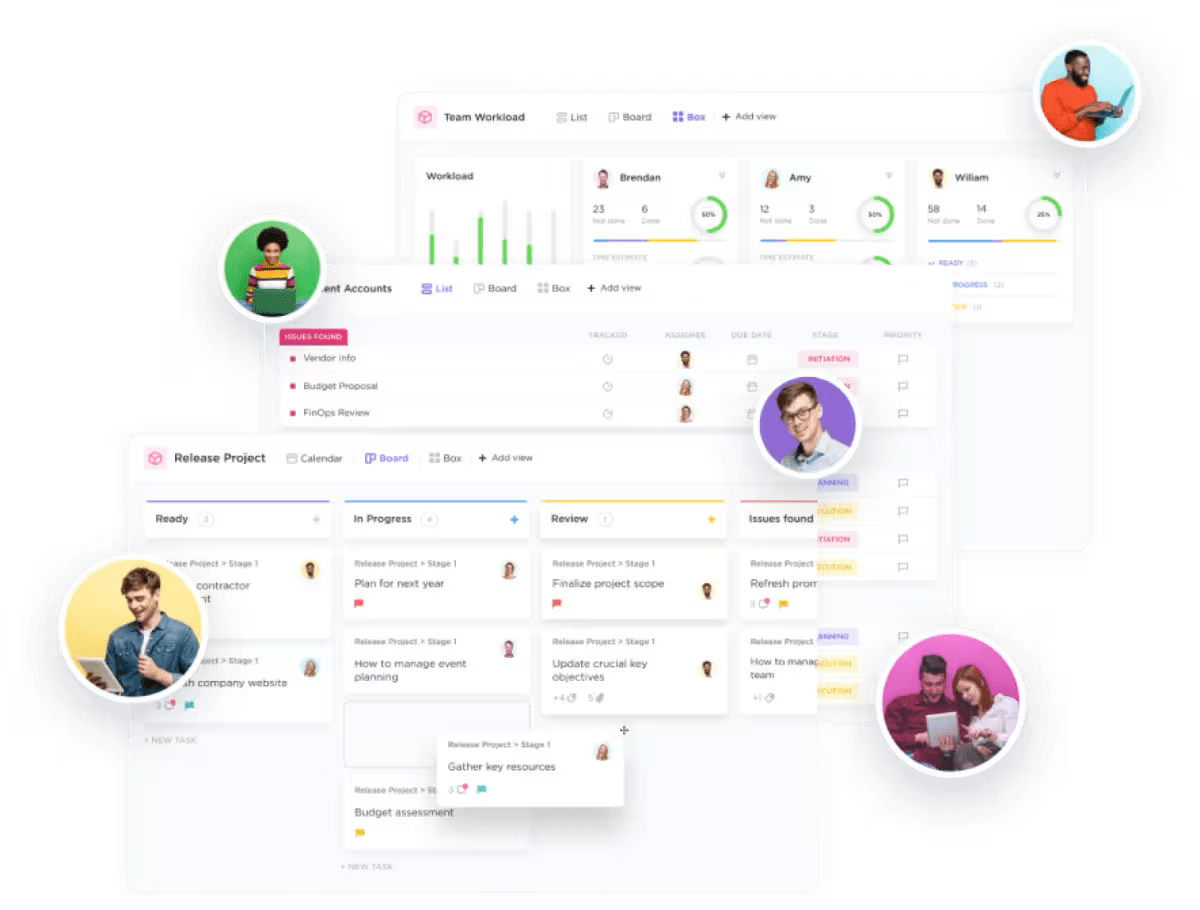
To ensure that your projects run efficiently, your plans should include the following:
- A project scope that outlines the requirements, timeline, budget, and resource allocation
- Inventory and resource management—tools and materials needed to complete the project and the contractors and other workers that you will be working with
- Permissions, certifications, and licenses for your project
- Quality and safety protocols
- Weather forecast and mitigation plan
- Contingency plans—in case your projects overshoot deadlines or budget

ClickUp Whiteboards can help you create detailed plans and blueprints for your projects. Packed with incredible features, your entire team can use it to brainstorm and get a birds-eye view of all the tasks in a construction project.
Takeaway: Start with a detailed plan and involve others in brainstorming ideas
2. Practice open communication and document everything
Once a project begins, follow a simple practice: document everything. From completed tasks and requirements to potential risks or delays, ensure you get every activity factored into the construction management software.
Project leaders must build a culture of open communication and collaboration to encourage team members to share their status updates and feedback. This helps ensure transparency and keeps your project activities on track. Moreover, it helps identify potential risks, so you can have contingency plans ready to mitigate them.
Remember, connected and informed teams are productive teams, and that translates to better results for your project.
Using ClickUp Docs, you can create impactful documents, wikis, and project plans that allow your teams to collaborate in real time. They can work on the same document with you, and you can assign them action items, add comments, and convert text into trackable tasks to keep up with all your ideas.
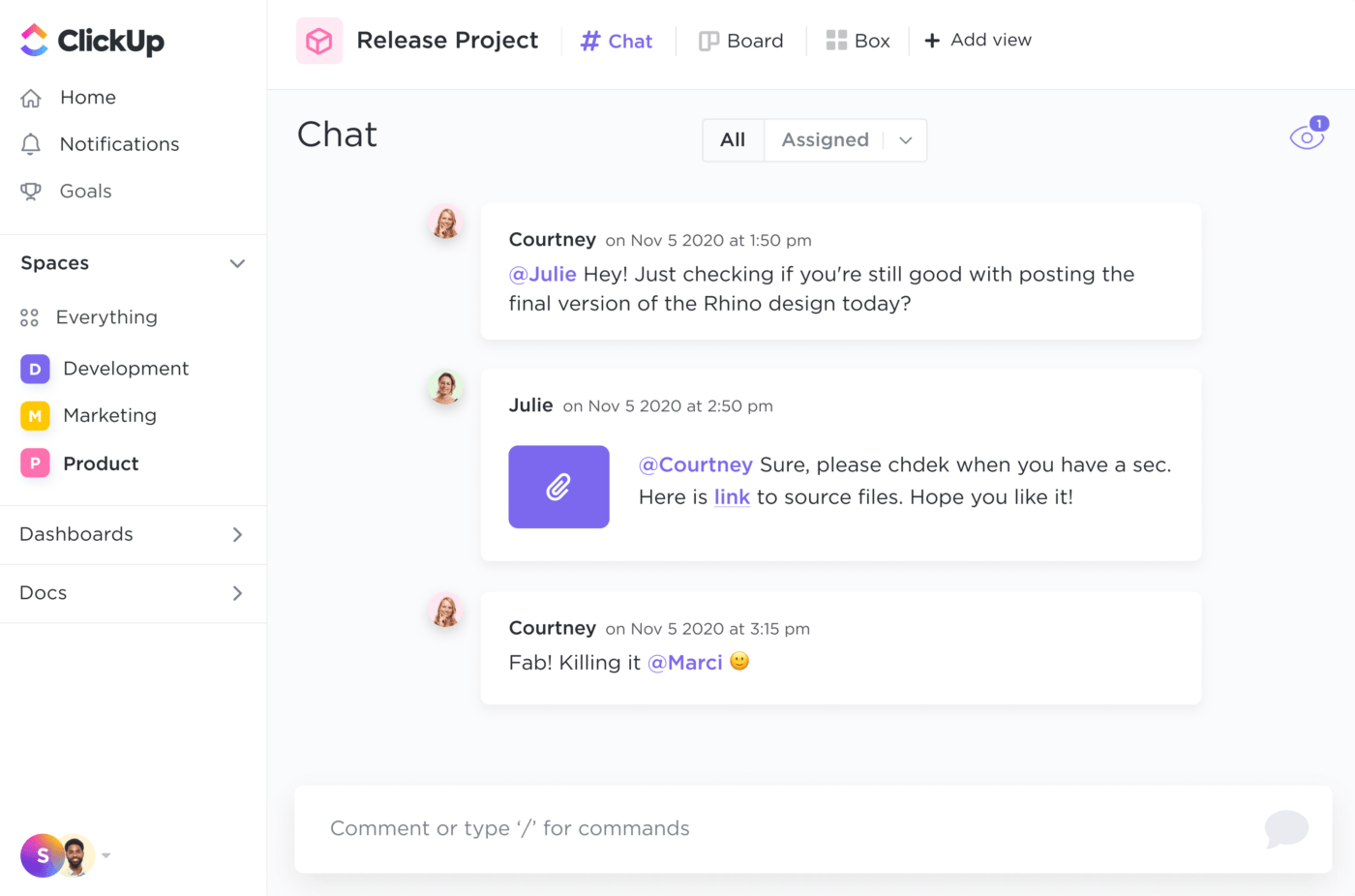
Plus, the real-time chat feature further helps you get all your conversations involving multiple projects or timelines under one roof. With ClickUp Chat, you can share project links and send attachments conveniently grouped. The messages can be formatted with rich editing features, helping you save time and send all your codes, lists, banners, and other details.
Takeaway: Document everything and communicate for transparency
3. Invest in employee training for higher productivity
Several automation tools and technologies are now being used to streamline construction processes. However, if your team cannot properly utilize this advanced technology, it can lead to delays. Worse, it can even create potential risks or accidents. To avoid this, train your workforce about the latest methods, safety protocols, and tools that they can use to increase efficiency. Also, arrange for tutorials on using the latest software and tech and encourage them to upskill with construction certifications. This helps your teams gain the critical skills to work faster and smarter, avoiding costly mistakes that can add to your project costs.

ClickUp Docs allows you to create a shareable knowledge repository with SOPs and learnings from previously worked upon projects. This can come in handy so that the entire team is on the same page regarding any information and updates.
Takeaway: Keep team skills updated
4. Prioritize safety on the job site
A safe workplace is a productive workplace. When safety protocols are followed, there are fewer delays, and your crew can work efficiently with fewer interruptions.
Implement a comprehensive safety program, conduct regular inspections, and consider using safety tech. Remember, protecting your team is the right thing to do, and it also helps minimize delays and disruptions and keep your project on track.
Takeaway: Invest in safety measures and programs
5. Approach potential supply chain issues with foresight
Imagine arranging all the resources, machinery, and due diligence for a crucial activity. However, the required material is unavailable at the very last minute. Frustrating, right?
This is a common situation in the construction industry and why most projects fail to meet their timelines. To avoid this, implement smart inventory management, and restock or reorder items being used up.
Build strong relationships with your vendors and inform them early about your requirements. This helps you anticipate potential supply chain issues and keep your projects running smoothly.
Takeaway: Manage your inventory and prevent supply chain breakdown
6. Use modular construction and prefabrication techniques
Traditional structures often require a lot of heavy lifting, including installing steel beams, building materials on-site, making adjustments as needed, and taking on each process one step at a time. However, new technologies can make the construction process faster and more efficient. By using modular or prefabricated construction materials, you only need to get all the materials together and install them in the building.
This helps you build faster, reduce waste, and maintain the overall quality of the construction project.
Takeaway: Modular construction is more efficient
7. Embrace automation to revolutionize construction processes
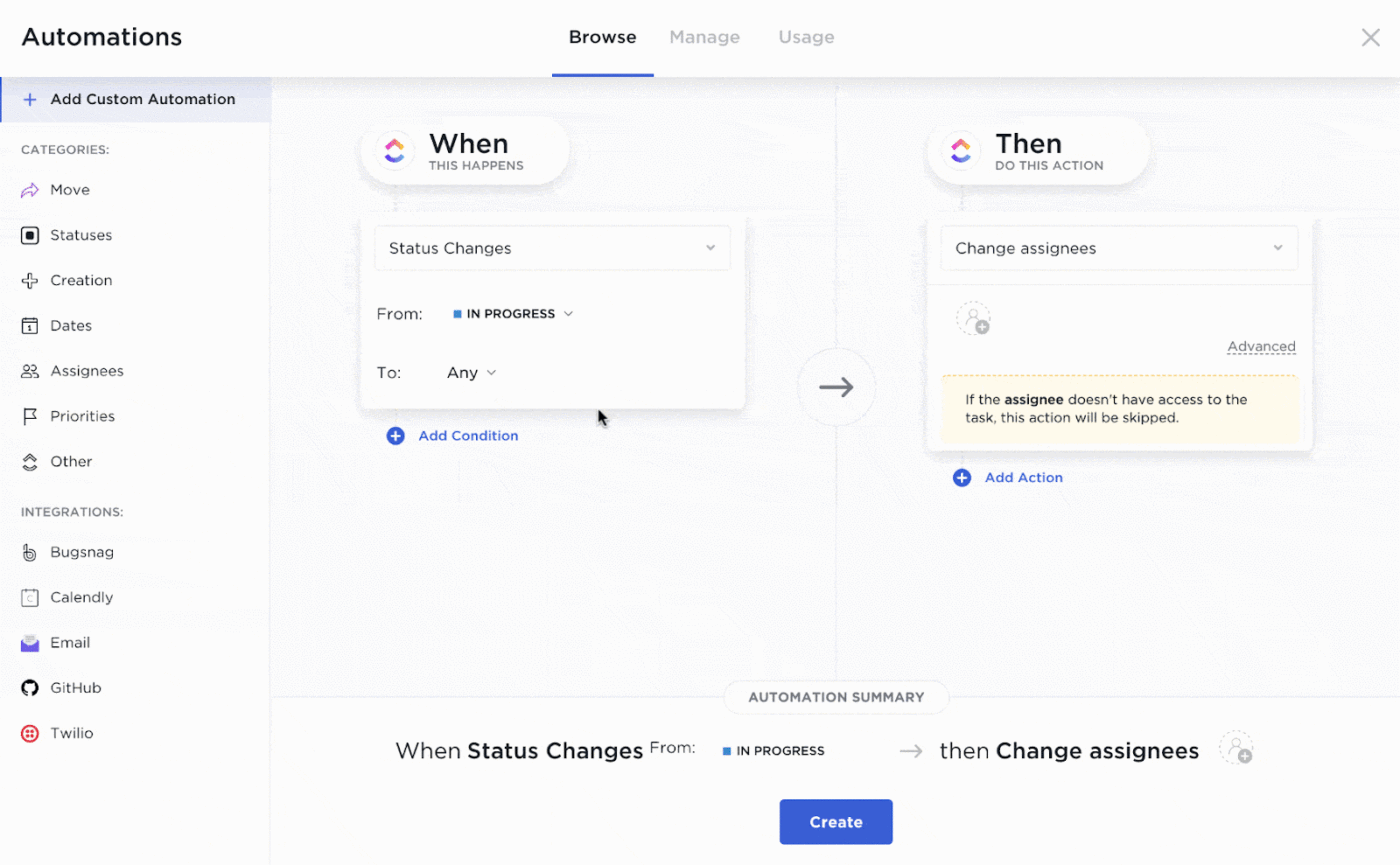
Automation can expedite construction timelines by incredible margins. If carried out properly, automation via machines, electrical tools, and advanced systems can help you free up your workforce for additional, more important tasks. This can help speed up the process and ensure your workers do not have to work tirelessly around the clock.
Project management software like ClickUp also helps you automate repetitive tasks like updates and more, saving you and your team leads valuable time.
The time saved can then be utilized for surveying, inspections, and other crucial jobs, ensuring you get the best of automation and human expertise.
Takeaway: Automation saves you time, effort, and money
8. Set clear and measurable performance goals
Creating a realistic project plan is the best way to avoid delays and minimize risks. Project managers can miss adding a safety net in their plan in the race to complete projects in record time. Thus, if a single task gets delayed, it creates a domino effect, and things start spiraling. Establish clear, measurable, achievable, relevant, and time-bound (SMART) goals for budget, timeline, and quality. Also, track progress regularly and adjust as needed. Clear goals keep everyone focused and motivated, driving your project towards success.
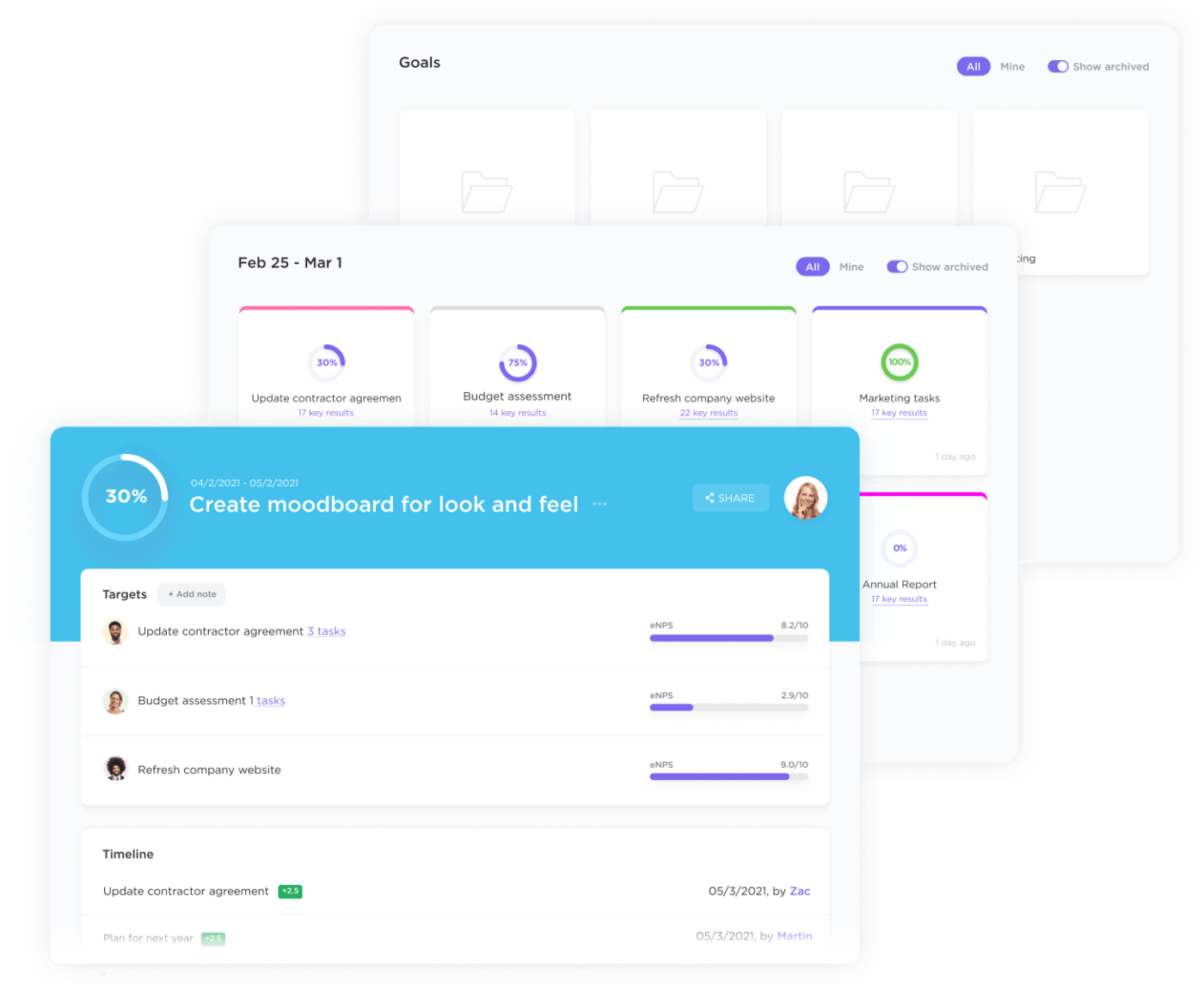
Use ClickUp Goals to ensure you are in tune with the organizational goals and have all the data points like project progress, weekly employee scorecards, sprint cycles, OKRs, and other important information handy.
Takeaway: SMART Goals are a win-win
9. Streamline construction processes for greater efficiency
In addition to automation and leveraging new-age construction strategies, you should also analyze and improve your existing processes. Advanced project and resource management solutions give you a holistic view of your organization. You can plan future projects and improve construction efficiency by learning from things that went wrong and the roadblocks you encountered.
Use this data to standardize practices, templatize processes, minimize waste, and encourage continuous improvement. This will help you fine-tune your construction processes, ensuring the operation runs smoothly and delivers expected results within planned timelines.
With ClickUp’s construction management templates, you can quickly get started with your construction project plans. You can:
- Plan and visualize everything from sales to project lifecycles
- Align team and contractor resources for smooth collaboration to get the job done
- Track progress and goals to ensure you deliver on time and within budget
Takeaway: Standardization can add value
10. Leverage an end-to-end project management tool for efficiency in construction
The construction industry has increasingly relied on digital tools and construction management software to stay on track and manage multiple construction projects simultaneously. A project management solution helps you plan all your activities (plans, schedules, budgets, communication) in one central hub.
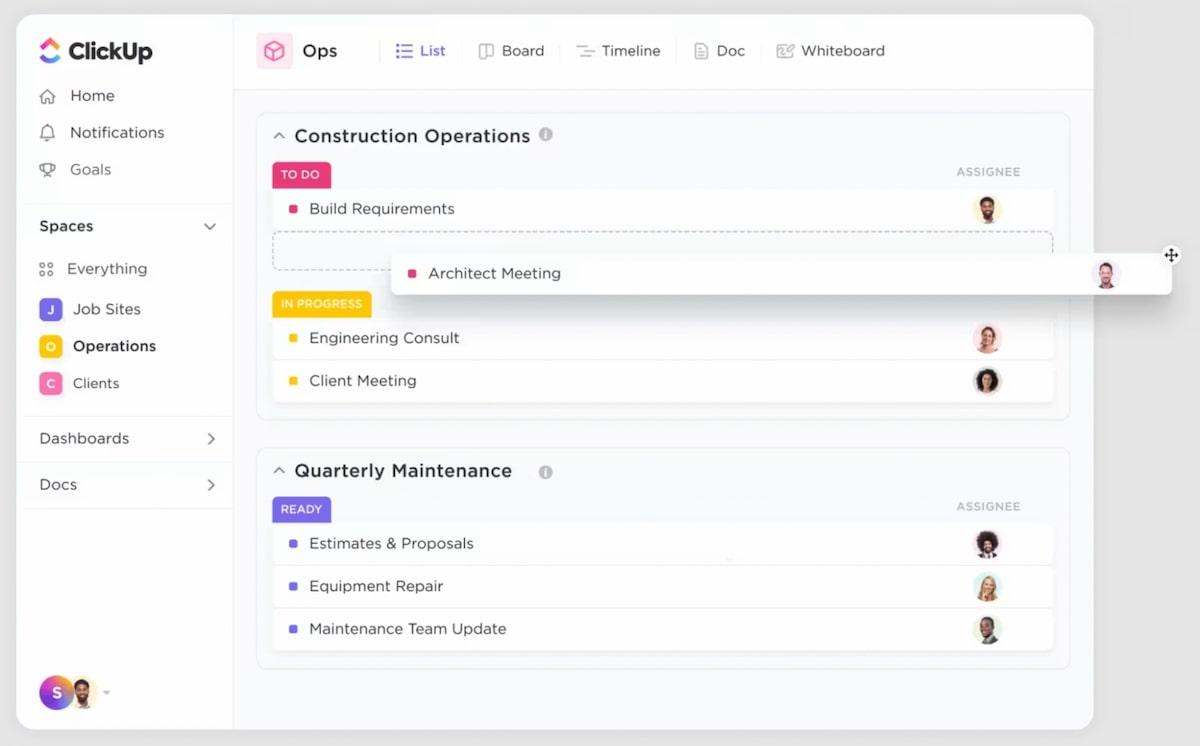
ClickUp is the top-rated productivity and construction project management software that offers an all-in-one solution to help you manage all your construction activities seamlessly. Whether managing tasks, resource allocation, finances, inventory, tracking progress, or any other requirement, you can use this solution for all your needs. Think of it as your construction command center, keeping everything organized and accessible for optimal project control.
Takeaway: Stay organized and efficient with ClickUp
Related: Construction project management software for Mac users
Time to Start Building—The Right Way
Managing a construction project is no easy task; you must plan, coordinate, and execute each activity meticulously to ensure the project gets delivered smoothly. Since this involves multiple processes, stakeholders, and building blocks, single-point construction management software can help you track performance metrics, simplify time-consuming tasks, and improve operational efficiency.
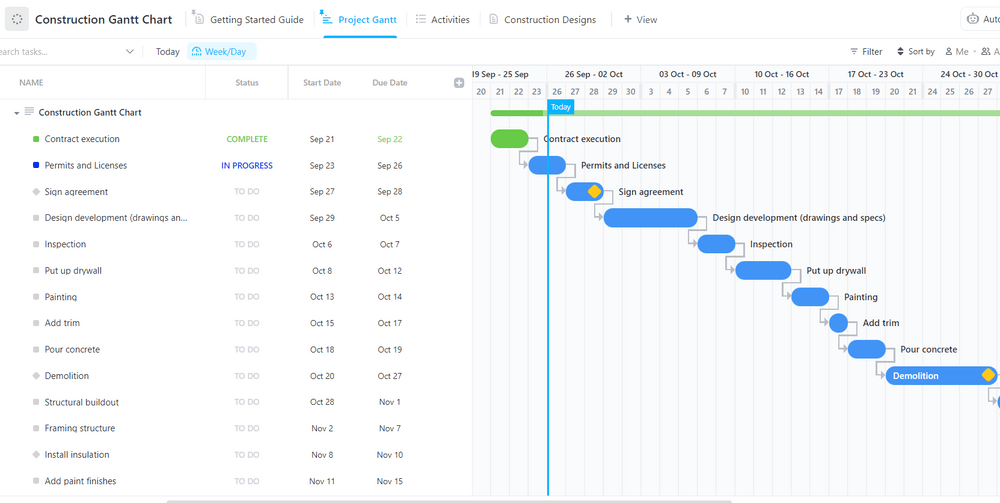
That’s precisely what ClickUp Construction Project Management software does! With built-in construction workflows and ready-to-use ClickUp construction templates for your task and resource-tracking, you can plan, manage, and track all your construction activities from one place.
Instead of trying to track a dozen activities manually, simply create tasks in ClickUp with timelines, owners, and other information. Use ClickUp’s Gantt Charts and Timeline View to track daily progress.
ClickUp’s AI Project Manager will also automatically create project updates, find dependencies and roadblocks, create the necessary sub-tasks, and help you keep everything on track.
ClickUp’s advanced features enable construction companies to leverage an end-to-end solution to improve operational efficiency and simplify processes. Get started with a free trial today to ensure all your projects are delivered cost-effectively.
Common FAQs
1. What is construction efficiency?
Construction efficiency, in simple terms, is the ability of a company to complete a project with minimum wasted effort or expense as per the project deadline. It focuses on optimizing resources, minimizing delays, and tracking time, cost, and resources to strike the perfect balance of cost-effectiveness without sacrificing quality.
2. How do you measure construction efficiency?
Construction efficiency is the ratio of output to input in a construction project. It is measured using critical metrics like project completion time, budget variance, resource productivity and utilization, percentage of material waste, safety incident rate, and more. Using ClickUp, you can track and define customer metrics within your project dashboard to ensure your construction projects are always on target.
3. What is operational efficiency in construction?
Operational efficiency is streamlining your day-to-day construction operations to maximize productivity and output. This includes aspects like:
- Effective task management and resource allocation
- Clear communication and collaboration across teams
- Optimized workflows and processes
- Efficient use of technology and tools
- Proactive problem-solving and risk management




